



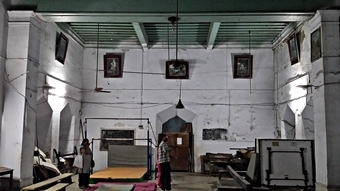
MK (‘Mahatma’) Gandhi matriculated (gained the qualifications for entering university) in 1887. He enrolled at Samaldas College in Bhavnagar in Saurashtra. This is a photo of the room in which Gandhi studied at Samaldas College. It is now use as a gymnasium by a girl’s school (Majiraj Girls High School).
Gandhi wrote of his time in Bhavnagar in his book The Law and the Lawyers:
“There was a college in Bhavnagar as well as in Bombay, and as the former was cheaper, I decided to go there and join the Samaldas College. I went, but found myself entirely at sea. Everything was difficult. I could not follow, let alone taking interest in, the professors’ lectures. It was no fault of theirs. The professors in that college were regarded as first-rate. But I was so raw. At the end of the first term, I returned home.”
The Pil Garden in the centre of the city of Bhavnagar (in the Saurashtra district of Gujarat) is a pleasant place to relax. Triangular in plan, the park is named in honour of Sir James Braithwaite Peile (1806-82)[1]. Educated at Oxford University, he entered the (British) Indian Civil Service in 1855. He went to India the following year. He learnt Gujarati and worked in many places in Gujarat including Bhavnagar. Between 1874 and ’78, Peile served as a Political Agent in Saurashtra. He helped to coordinate the activities of the numerous heads of Princely States in the area, including that of Bhavnagar. He also helped organize famine relief during the great famine of 1877. Peile gained the respect of the heads of the Princely States. Mr Peile described the Kingdom of Bhavnagar as follows:
“With flourishing finances and much good work in progress. Of financial matters I need say little; you have no debts, and your treasury is full.[2]”
Peile left India in 1887, but his name has been immortalised in Bhavnagar by giving it, slightly oddly spelled, to a lovely public garden.

We visited the Pil Garden earlier this year. While I was wandering around, I came across a carved cube of stone partially hidden in some vegetation growing around it. There was an inscription in Gujarati script on one of its faces. On another face, I saw a carved Scottish thistle with some letters carved beneath it: A_RUC_ _ _ L U (or II) S. A third face was carved with a bas-relief depicting the profile of a man wearing a jacket and tie. The face parallel to that bearing the inscription in Gujarati bears the English words: “The Percival Fountain erected by public subscription in 1879 as a mark of esteem for _ _ _ Percival Esq, Bombay Civil Service, Joint Administrator of the State.”
The Mr Percival mentioned on the stone must have been Mr EH[3] Percival of The Bombay Civil Service. His title ‘Joint Administrator of the State’ needs explaining. When Jaswantsingji, the Maharaja of Bhavnagar died in 1870, his son and successor Takhtsingh (1858-96) was only twelve years old, too young to handle the affairs of his state. Until 1878 when he attained his majority, his kingdom was administered by two men[4]: Gaorishankar Udayashankar (1805-1892), a senior and experienced administrator of Bhavnagar, and EH Percival of the Bombay Civil Service. Takhtsingh became a fine ruler of Bhavnagar, executing many useful projects that benefitted his subjects for a long time.
Mr Percival’s administration was considered to have been beneficial to the Indian subjects of Bhavnagar. Even the socialist HM Hyndman (1842-1921), who was a vehement critic of the activities of the British imperialists in India had to admit in his book The Bankruptcy of India (published 1886):
“The independent Principality of Bhaunagar was for eight years, 1870-78, under the joint administration of Mr. Percival, a Bombay civilian, and the old State Minister. During this period a complete change took place. The government was reformed in every part, a revenue survey was introduced, and the revenue and trade greatly increased buildings of all sorts, public offices, schools, hospitals, tanks, roads, bridges, lighthouses. So the Bhaunagar State is now by far the most flourishing in Kattywar[5], and the cause of its recent and rapid advance is by common consent allowed to have been the benign influence of Mr. Percival’s presence.”
These were indeed words of praise coming from the pen of a man who believed that the presence of the British in India was hastening the subcontinent’s rapid decline and was doing the Indians no good at all.
One of the many improvements made during Percival’s administration was the city’s water supply. I quote the following, which describes an important urban problem in Bhavnagar and Victorian India in general, from a biography[6] of Percival’s co-administrator Gaorishankar Udayashankar:
“For many years the people of Bhavnagar had Suffered for want of a supply of good drinkable water. During the summer season the fresh-water wells in the City failed, with the exception of one or two. Even in the case of this latter, it was painful to see fifty or sixty women gather round the deep well struggling hard to fill their canvas buckets with the limited supply to be found at a considerable depth. Most of the people obtained their supply from temporary wells sunk in the bed of the river Ghadechi, and from a well close by the river, but situated at a distance of two miles from the town, ‘The climatic changes and ‘scarcity of water’, remarked Dr. Burjorji Behrmji, L.M., in a report, ‘influenced the salubrity of the town to a marked degree, and brought on an increase of illness in the shape of malarious fevers, bronchitis, diarrhoea, dysentery, guinea- worm, and dyspepsia in various forms.’
Mr. Gaorishankar had long desired to relieve the 40,000 inhabitants of Bhavnagar by giving them a good water-supply. With the advice and cordial co-operation of Mr. Percival, who thoroughly appreciated this want, he now set about the work in sober earnest. It was found that two miles up the river Ghadechi, there was an excellent site for a large reservoir… The canal carries the water into a reservoir situated in the heart of the town, which supplies, by means of pipes, pure wholesome water to the principal localities. The completion of the works cost the State Rs. 6,00,000. When they were opened to the public, they were, at the desire of Mr. Percival, named after Mr. Gaorishankar.”
What is left of the Percival Fountain might have been part of a gift to celebrate his assistance in the improvement of Bhavnagar’s water supply.

Of the thistle mentioned earlier, I have discovered that some Percival families use the thistle as part of their coat-of-arms. It is likely that EH Percival was Edward Hope Percival (died 1904), who was married to Louisa Jane Wedderburn (1842-1895), daughter of Sir John Wedderburn (1789-1862), who was in the service of the British East India Company. According to a source in the National Library of Scotland[7], Louisa Jane:
“Married at Tibberton, co. Gloucester, 7 Jan. 1869, Edward Hope Percival, of the Indian Civil Service…”
Louisa Jane was the first of her siblings not to be born in India.
Although I have so far been unable to find out the dates of Edward Hope Percival, I have discovered that his collection of various artefacts and peepal tree leaves collected in Bhavnagar were presented to Oxford’s Pitt Rivers Museum by his grand-daughter Alicia C Percival. In their Annual Reports, they refer to Edward Hope Percival as being “Adviser in Bhaunagar State in the Bombay Presidency during the regency of the Maharajah[8]”, thus confirming that EH Hope was Edward Hope Percival.
I am very pleased I discovered the semi-neglected stone in Bhavnagar’s Pil Garden because it has opened up a small window into the colonial past of India.
[1] Biographical details from Dictionary of National Biography (on-line edition)
[2] https://bhavnagar.nic.in/history/
[3] Probably Edward Hope Percival
[4] https://en.wikisource.org/wiki/1911_Encyclop%C3%A6dia_Britannica/Takhtsingji
[5] i.e.: Kathiawad, another name for Saurashtra
[6] Gaorishankar Udayashankar, G.S.I., ex-minister of Bhavnagar, now in retirement as a Sanyasi, by JU Yajnik, publ. Bombay: about 1889.
[7] https://digital.nls.uk/histories-of-scottish-families/archive/95655759?mode=transcription
[8] http://web.prm.ox.ac.uk/sma/index.php/museum-annual-reports/260-1959-60-annual-report.html

Salt is an essential part of the human diet. In Africa, salt produced by the Moors was transported across the Sahara Desert to salt-free Central Africa, where it was exchanged for gold. This shows how much salt is valued as a commodity.
On a recent bus trip between the two Gujarati cities of Baroda and Bhavnagar, we passed through a flat low-lying district not far from the sea (the Gulf of Khambat). Along the way, we passed numerous white piles of salt recently extracted from the sea. These piles stand amongst pools of salty water that is evaporating in the hot sun. Although flat, the landscape is varied and fascinating.
Gujarat is the largest salt producer in India and the third largest in the world. Sadly, the salt workers, whose life is tough and dangerous, are poorly treated by their employers. According to the Indian Express dated April 26, 2016, the Government of the State of Gujarat is looking into ways of improving the lives of salt workers and their families.

Mahatma Gandhi studied for a few months at Samaldas College in Bhavnagar. The Gandhi Smruti in that city contains a first class collection of photographs recording the life of the Mahatma. This echibition is on the first floor of a building. Its ground floor is occupied by the exhibits in the city’s Barton Museum.
The Barton contains some fine artefacts made in different eras. Amongst these, there are some lovely Jain stone carvings.
One area of the museum oncludes a case showing the evolution of the flag of what was to become post-colonial India. Near to this, there is a vitrine containing ageing historic postage stamps in various states of decay.
While looking at the stamps, I spotted several bearing the name “Ifni”. Never heard of it? Well, I had. I used to spot Ifni on the pages of atlases published before the 1960s. However, I had never seen stamps bearing this name.
Ifni was a tiny Spanish colonial enclave on the Atlantic coast of Morocco. The Spanish ruled Ifni from 1860 until 1969, when it was returned to Morocco. The Sultanate of Morocco had ceded the tiny piece of land to Spain in 1960.
According to an article in Wikipedia, Ifni issued several new postage stamps each year. More of them remained unused than used.
I do not know who donated the sheets of postage stamps to the Barton Museum in Bhavnagar, but those from Ifni were certainly isdued orior to 1969.
The museum in Bhavnagar is, like many other museums in provincial towns in Gujarat, filled with a variety of artefacts. You never know what you will find when you enter one of them. The stamps from Ifni were certainly unexpected.
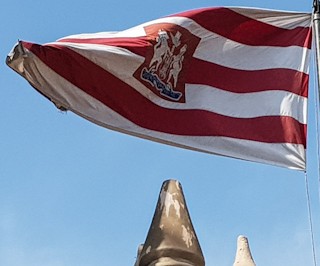
Bhavnagar is a very pleasant, but less visited, city in Gujarat’s Saurashtra peninsula. Close to the sea, it was established by the Gohil dynasty in the 18th century
We arrived in Bhavnagar in late January 2019 after spending a week in Baroda. The weather in Baroda was warm (29 to 31) degrees Celsius and we need to use air conditioning even in the evenings.
Here in Bhavnagar there are cooling breezes. The daytime temperature is extremely pleasant. At midday, the temperature hit a high of 24. At night, the air becomes distinctly chilly even for someone used to British weather. Air conditioning is not required at all at the moment. Locals dress up warmly with heavy outer clothing and warm head gear.
Straying away from meteorology, Bhavnagar has a very friendly climate. People are friendly, humorous, and helpful.
To exemplify the above, let me tell you about one incident. My wife and I were ordering tea at a roadside chaiwalla stand. A man sitting close by waved a banknote at us and insisted on paying for our tea. As he did so, he said in Gujarati:
“You are our guests in Bhavnagar “.
This kind of behaviour is typical of the welcoming folks in Bhavnagar.

In London pigeons are regarded as a nuisance, as pests. A previous Lord Mayor of the city once described them as “flying rats”. Now, feeding them is frowned upon. Gone are the days when you could buy corn to feed the pigeons in Trafalgar Square.
During our long journey through Gujarat in western India, we saw many places dedicated to feeding pigeons. In Bhavnagar, for example, I saw a man scattering seeds, which were being avidly consumed by a large crowd of grey pigeons. The grain was strewn over a large area in which there were several large bowls of water to quench the birds’ thirst.
In Ahmedabad, we saw a fenced off area supplied with drinking bowls as already described. This special feeding area was well supplied with grain scattered on the ground. In that same city, we saw a huge pigeon ‘hostel’. This consisted of a matrix of niches or pigeon holes in which the creatures resided. Feeding facilities were adjacent to the niches. This giant pigeon coop was next to a mosque or dargah close to the Nehru Bridge over the River Sabarmati.
In Rajkot, we spotted a cylindrical concrete pigeon coop mounted on a tall concrete pillar. And, in Porbandar a large area close to the beach is used to feed pigeons and other birds at the end of an afternoon.
During our very recent visit to the metropolis of Hyderabad in Telengana State, we have driven past pigeon feeding areas. On one of the bridges crossing the river, one of these feeding places occupied the whole length of one side of the bridge.
When wandering around the many bookshops in the Koti district of Hyderabad, we found a square surrounded by buildings. The centre of the square is a fenced open space where thousands of pigeons collect to feed on the copious amounts of grain on the floor. This area is overlooked by a cylindrical pigeon coop, which is illustrated above. The area is maintained by The Pigeon Welfare Association of Telengana.
The Lalbagh Gardens in Bangalore have at least one fine large cylindrical pigeon coop. I do not know how many other places in India care for pigeons as I the places I have mentioned, but from what I have seen so far, I can say that India is not devoid of popular concern for avian wellbeing.

Travellers visiting Gujarat should be aware that the majority of food served in the state is vegetarian. In bigger places like Ahmedabad and Baroda, finding non-vegetarian food is less of a problem than in smaller places. If you visit Bhavnagar, the Nilambagh Palace Hotel serves very good food – both veg and non-veg. Many people hanker after Gujarati thalis, but I am not one of these people. Those who are not on the Gujarati meals can easily find well-prepared south Indian vegetarian food like dosas, idli, and vada. Pizzas are also widely available, often with excellent tomato sauce made with fresh tomatos.

Another thing to consider when planning your trip to Gujarat is that it is a dry state: alcohol is not served in any public places. It is possible to get a permit (I have no idea how) to be allowed alcohol ‘for medical purposes’ (!) Gujaratis and others desperate for booze can cross the border into either Daman or Diu, both of which were Portuguese colonies until 1961. Now they are administered not by the State of Gujarat, but by the Central Government of India – they are Union Territories. Alcohol is freely available at almost duty-free places in these tiny places, both of which are well-worth visiting.

If you are thirsty, there are plenty of soft drinks available including the refreshing watered down yoghurt drink chhas (also known as ‘buttermilk’). Tea is the prevalent hot drink. We found it hard to get decent coffee, let alone any coffee. Most Gujaratis in Kutch and Saurashtra seem to be keen tea drinkers.
Discover more about journeying through Gujarat in Adam Yamey’s new book:

Hop on a bus and travel through Gujarat: see the country and enjoy the people
More excerpts from “Travels through Gujarat, Daman, and DIU“, a travelogue by Adam Yamey, available HERE IN PAPERBACK and HERE ON KINDLE

During our eight weeks of travelling through Gujarat, Daman, and Diu, we made much use of public transport. We used mainly buses. As in other parts of India, some buses are run by private companies, and other by the local state, in our case Gujarat, which operates under the name ‘Gujarat State Road Transport Corporation’ (‘GSRTC’). At the outset, we made the assumption that privately-run buses are bound to be better than those run by the state. It was only near the end of our travels that we discovered that we had made an erroneous assumption.
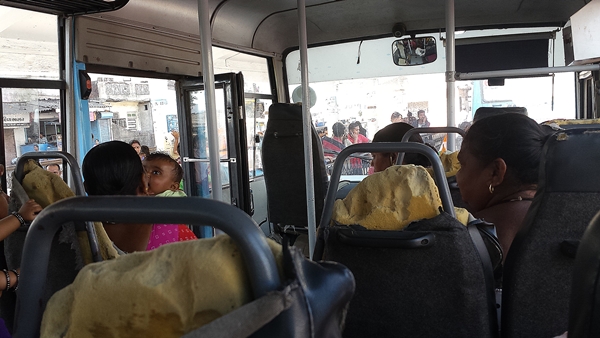
Here are some extracts about buses in Gujarat from my book “Travels through Gujarat, Daman, and Diu”:
On a private bus between Junagadh and Porbandar:
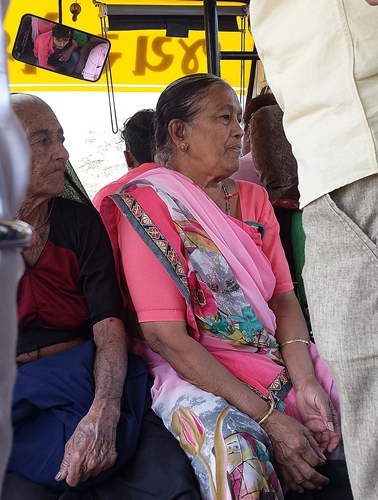
“Our vehicle stopped frequently. Whenever the conductor saw someone standing by the side of the road, he leaned out of the open passenger door, shouting our destination repeatedly: “Porbandar! Porbandar! Porb…” More and more people boarded our small bus. All the seats became occupied as did the space at the front of the vehicle around the driver. As the bus picked up even more people, even the standing room became used up. People were jammed against each other and their arms and baggage invaded the seated passengers’ space. A lady began resting her bag on Lopa’s head. When she objected, the woman said: “Where else can I put it?” Another person almost sat on Lopa’s lap.
There was hardly any room for the conductor. He spent most of the journey leaning out of the passenger door. When Lopa asked him whether this was dangerous, he responded cheerfully that it was part of his job. After about an hour, when the bus was already incredibly crowded we stopped in a village where a large group of people were waiting for our arrival. The bus driver told the conductor that there was no room for any more people. The conductor ignored him and squeezed many new passengers on board.

Our fellow passengers were a varied crowd. They included men with curling handle-bar moustaches wearing turbans and loose-fitting white kurtas with baggy trousers. Their clothes were often stained probably because they were worn whilst doing work on the land. At many rural stops, women wearing colourful garb boarded. Many of them were tattooed on whatever parts of their bodies that could be seen and probably also on parts that were not visible in public…”
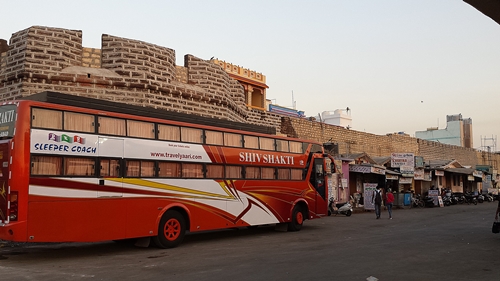
On a GSRTC bus between Diu and Bhavnagar:
“We boarded a bus belonging to the Gujarat State Road Transport Corporation (‘GSRTC’). This and other buses belonging to the state-run bus company are superior to any of the private busses we had travelled on. The GSRTC vehicles: are cleaner and more comfortable than the private ones; only stop at bus stands with good facilities; do not tout for business at random wayside stops; and do not admit more passengers than there are seats to accommodate them. We wished that we had not assumed, wrongly, that privately-run buses would be better than those run by the state.”

On a GSRTC bus to Ahmedabad:
“We boarded the newest and most comfortable bus of our trip at Baroda bus stand. Part of the GSRTC fleet, it was a Volvo vehicle. These buses are held in high regard by Indians. As far as buses in India are concerned, they are regarded as Maharajahs amongst the myriad of road transport vehicles. The coach driver asked Lopa her relationship to me. She replied that I am her husband. The driver shrugged his shoulder and replied in Gujarati: ‘It happens’.”

Whether the bus is privately, or state operated, a ‘back-seat driver’ like me cannot avoid being aware of the adventurous driving of the bus drivers:
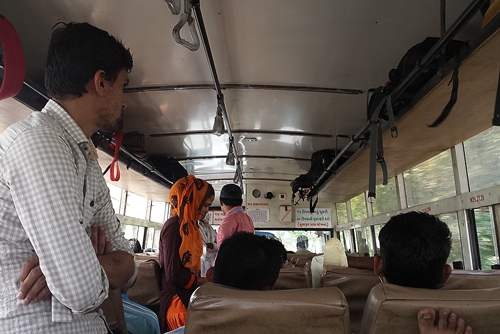
“Our driver sped along the good roads leading towards the eastern edge of Saurashtra. He overtook frequently and usually hazardously. Often, he had his head turned towards the conductor sitting left of him, chatting with him, rather than looking ahead along the road in front of him. He also made frequent ‘phone calls to people with whom he was doing business, buying and selling vehicles.”
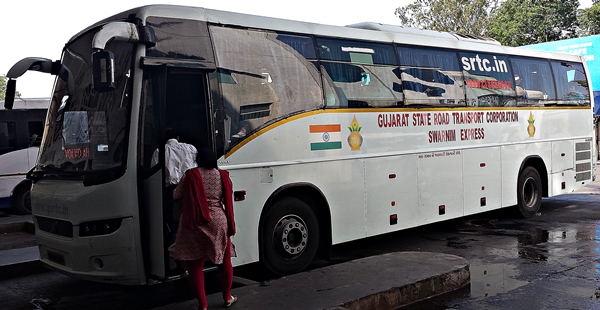
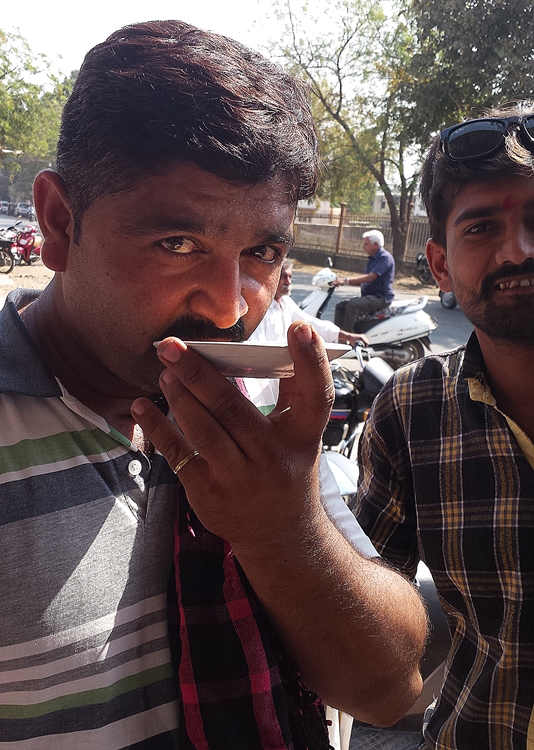
… all over Gujarat, tea is served in tiny cups, that can be finished in two or three swallows. It is invariably sweet. Our daughter describes these minute drinks as ‘sugar bombs’. They provide energy, rather than quenching thirst. Often, two men will share a tiny cup of tea. Half of the tea is poured into a tiny saucer, and one of the men slurps from it noisily. The other man drinks the rest from the cup. Tea shared this way is known as ‘cutting chai’. A reason for this practice is, apparently, to reduce sugar intake.
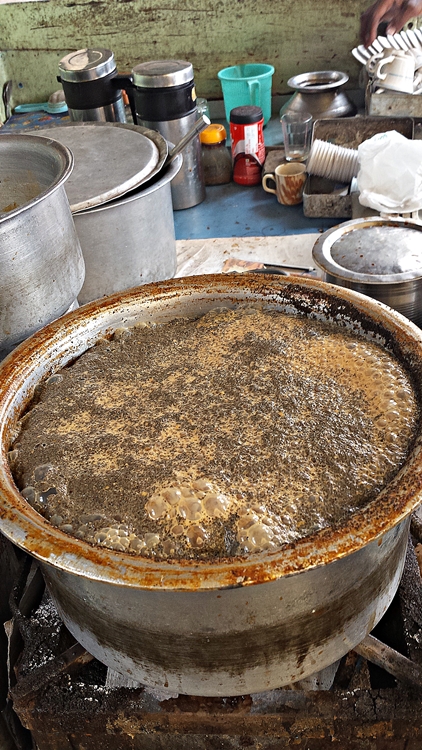
DISCOVER MUCH MORE ABOUT GUJARAT BY CLICKING HERE
AND HERE